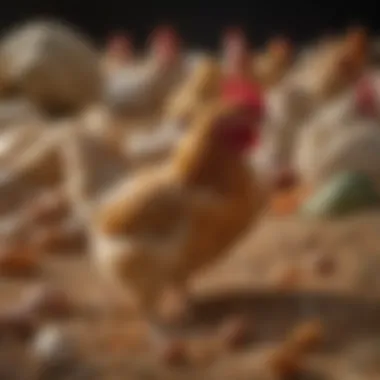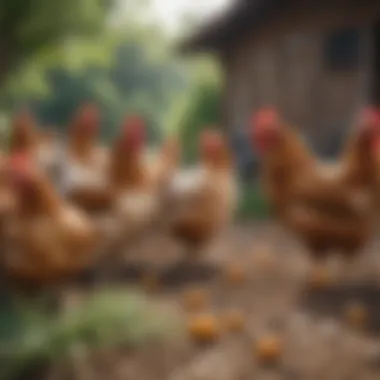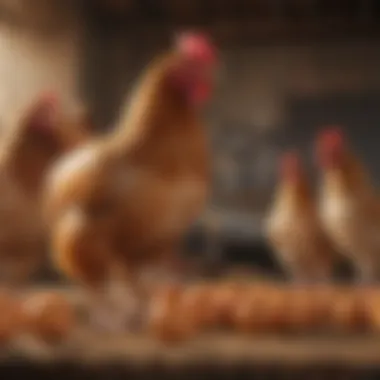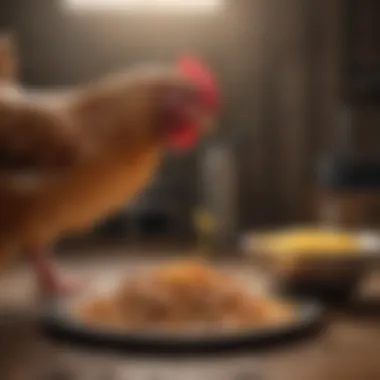High Protein Food for Chickens: Essential Nutritional Guide


Intro
In the world of poultry management, nutrition stands out as a central pillar for the health and productivity of chickens. High protein food is critical. Protein influences egg production, muscle development, and overall vitality throughout their various life stages. In this guide, we'll explore the significance of high-protein diets, outlining their benefits and identifying suitable sources and feeding strategies. By focusing on practical recommendations, this narrative aims to empower both novice and experienced chicken owners to make informed feeding choices that promote optimal growth and health for their flock.
The Importance of High Protein Food
High protein food for chickens plays a significant role in their overall development. Protein is not just a nutrient; it is the building block for muscle, feathers, and enzymes. Proper protein intake leads to healthy growth rates for chicks and supports robust egg production for laying hens. A balanced diet rich in protein ensures that chickens thrive, reflecting in their productivity.
Chickens require different protein levels at various growth stages, making it imperative for owners to adapt feeding strategies accordingly.
Recognizing Protein Needs at Different Life Stages
It is crucial to adjust the protein composition based on the age and purpose of raising the chickens. For example, chicks need a higher protein content in their initial feed to support rapid growth, while laying hens usually require sustained protein intake for efficient egg production.
- Chicks: Optimal protein percentage ranges between 20-24%.
- Growers: A reduction to 16-20% is suitable as they mature.
- Layers: Maintaining protein levels at around 16-18% ensures healthy egg laying.
Sources of High Protein Food
Knowing where to source protein-rich feeds is essential. Some excellent sources include:
- Soybean Meal: A common ingredient in poultry diets, highly digestible.
- Fish Meal: Rich in amino acids and omega-3 fatty acids, beneficial for egg quality.
- Peas and Lentils: Plant-based proteins that are great alternatives for animal products.
- Commercial Feeds: Many brands offer specially formulated feeds that cater to the protein needs of chickens.
Selecting high-quality feed is as important as the protein content itself. Evaluate supplements or read labels carefully.
Feeding Strategies for Optimal Health
To ensure chickens receive a balanced diet that includes sufficient protein, consider these strategies:
- Gradual Transition: Introduce new feeds gradually to minimize stress and digestive issues.
- Monitor Intake: Observe feeding behavior to ensure all chickens are consuming the appropriate amount.
- Adjust Ratios: Periodically assess and adjust feed ratios based on protein percentages and growth rate.
By implementing these strategies, poultry keepers can ensure that their chickens achieve optimal health and productivity.
Preamble to Chicken Nutrition
Chicken nutrition is a fundamental aspect of poultry management. By understanding what chickens need in their diet, owners can ensure they are providing optimal care. This guide focuses specifically on high protein food for chickens, necessitating knowledge of nutritional requirements to foster proper growth and health.
Importance of Protein in Chicken Diet
The role of protein in a chicken’s diet cannot be overstated. Protein is pivotal for growth, reproduction, and overall health. Chickens require protein for the formation of muscle tissue, feathers, and critical hormones.
Key Benefits of Protein:
- Muscle Development: Protein helps in building and repairing muscle tissue. This is essential for both meat and layer chickens.
- Egg Production: For laying hens, protein contributes to the production of eggs and the health of eggshells. Higher protein intake often correlates with increased egg size and quality.
- Immune Function: Adequate protein levels support immune system functionality, vital for disease resistance.
Chickens generally require higher amounts of protein during specific life stages. Young chicks and laying hens have increased needs compared to adult male birds. It is crucial to tailor their diet accordingly, ensuring they receive enough protein for their respective development stages.
Overview of Nutritional Requirements
Understanding the overall nutritional needs of chickens is complex but essential. Different classes of chickens need specific nutrient balances to thrive. Beyond protein, chickens require various other nutrients:
- Vitamins: Essential for metabolic processes, growth, and reproduction. For instance, Vitamin A is crucial for vision and immune health.
- Minerals: Nutrients like calcium and phosphorus are vital for strong bones and eggshells.
- Energy Sources: Carbohydrates and fats provide energy for daily activities.
To ensure the nutritional adequacy of diets, owners can utilize commercial feeds, natural sources, or homemade blends. Attention to these components is integral to maintaining healthy, productive flocks.


Nutritional balance is key. A well-rounded diet leads to better health outcomes for chickens, directly impacting their productivity.
Understanding High Protein Needs
Understanding the high protein needs of chickens is essential for optimal nutrition and health. Protein plays a critical role in growth, egg production, and overall well-being. This section delves into the specific protein requirements at different life stages, the connection between protein intake and egg production, and the distinct needs for meat-producing and egg-laying birds. By comprehensively understanding these aspects, chicken owners can make informed decisions to enhance the health and productivity of their flocks.
Stages of Growth and Protein Demand
The protein needs of chickens vary significantly throughout their life stages. Chicks, for instance, require a high protein diet to support rapid growth and development. During the first few weeks, they thrive on a starter feed containing 18-24% protein, which is crucial for muscle and skeletal development.
As chickens grow into pullets, their protein needs change. They still require a substantial protein intake, but it can be gradually reduced to around 16% as they approach adulthood. Maintaining sufficient protein levels during this stage is vital for laying hens to ensure they build adequate strength for egg production.
Once hens are laying eggs, their protein requirements shift again. Mature hens should receive diets with 16-18% protein to support not only their daily physiological functions but also the substantial energy needed for egg production. In contrast, meat birds, specifically broilers, demand higher protein levels, around 20-24%, to ensure optimal growth and muscle mass.
Impact of Protein on Egg Production
Protein directly influences the quality and quantity of egg production in hens. Higher protein diets can lead to increased egg size and better shell quality. This is due to the need for proteins in the formation of the egg itself, particularly the egg white and yolk. Notably, the amino acids found in protein are essential for the production of albumen, which provides water and protein storage for the developing chick.
Research indicates that hens consuming lower protein levels often exhibit reduced egg output. Over time, this can lead to decreased profitability for chicken owners who depend on egg production.
A balanced protein intake ensures healthier hens and maximized productivity.
Protein Needs for Meat and Layers
Different types of chickens have unique protein requirements based on their roles. Layers prioritize maintaining health and maximizing egg production; hence their protein content generally hovers around 16-18%.
For meat chickens, such as broilers, a protein-rich diet is essential. These birds grow rapidly and necessitate 20-24% protein to support muscle development and efficient feed conversion rates. Both types of chickens thrive on foods rich in amino acids. Key sources can include soybean meal, fish meal, and specialized poultry feeds. Ultimately, tailoring the diet according to the chicken's specific needs ensures not only animal welfare but also profitability for the owner.
Types of High Protein Foods
Understanding the various types of high protein foods is essential for maintaining a balanced diet for chickens. These foods not only provide the protein necessary for growth, egg production, and overall health, but they also come in several forms, presenting options for different needs. It is important to explore both commercial and natural sources of protein, in addition to homemade mixtures. This holistic approach helps poultry keepers make informed decisions about their chickens’ diets.
Commercial Feed Options
Complete Feeds
Complete feeds are formulated to provide a balanced diet in a single product. They contain all the essential nutrients, including proteins, vitamins, and minerals needed by chickens. One key characteristic of complete feeds is their convenience. They eliminate the need for additional supplementation, making it easy for chicken owners to ensure their flock receives adequate nutrition.
A unique feature is that complete feeds are often tailored to specific life stages—such as starter, grower, or layer feeds. This customization helps in meeting varying protein needs throughout a chicken’s life cycle. However, a disadvantage can be the reliance on commercial production, where quality may vary between brands.
Supplemental Feeds
Supplemental feeds serve to enhance the existing diet, adding more protein or other nutrients as necessary. They are particularly beneficial when the base diet lacks specific nutrients. A key characteristic of supplemental feeds is their flexibility; they can be added in small quantities alongside regular feed.
These feeds typically include protein-rich ingredients like soybean meal or fish meal, which significantly improve the protein content. Nonetheless, a consideration to be aware of is that over-reliance on supplements can lead to nutrient imbalances if not managed correctly. Therefore, careful monitoring is essential when incorporating these into the feeding regimen.
Natural Protein Sources
Legumes
Legumes are an excellent natural source of protein for chickens. They provide protein along with other nutrients that support overall health. A key feature of legumes like peas and lentils is their high digestibility, which makes them a preferred choice among poultry keepers.
One distinct advantage of using legumes is their ability to fix nitrogen in the soil, making them a sustainable option for home gardening. However, a downside is that these natural sources might not meet the protein needs when chickens require higher levels, thus they are best used in conjunction with other feeds.
Animal By-Products


Animal by-products, such as meat and bone meal, are rich in protein and can effectively boost a chicken's diet. A defining characteristic of these products is their high nutrient density, often providing more protein per serving than plant-based options. This makes them a potent choice for meat birds or layers.
The unique feature of animal by-products is that they often include essential amino acids, beneficial for muscle development and egg production. However, there are concerns regarding sourcing and potential pathogens, leading to some hesitancy among chicken owners in using these products. Proper sourcing from reputable suppliers is crucial for safety.
Insects
Insects represent a highly nutritious and natural protein source for chickens. They are not only rich in protein but also provide essential fats and minerals. A notable feature of insects is their high agricultural sustainability. Raising insects requires fewer resources compared to traditional livestock, presenting an eco-friendly option.
The immense protein potential found in insects, such as mealworms and black soldier fly larvae, is one advantage that makes them an attractive choice. However, a disadvantage may include the additional effort needed to cultivate or source those insects, as they may not be as readily available as grains or other feeds.
Homemade High Protein Mixtures
Creating homemade high protein mixtures allows chicken owners to customize their birds' diets. By using ingredients like grains, legumes, and vegetable scraps, these mixtures can be tailored to meet specific nutritional needs. This approach also reduces waste and promotes sustainability. Nevertheless, one must ensure the right balance of nutrients to avoid deficiencies or excesses. Monitoring and adjusting the mixture over time is important for optimal health and production.
In summary, understanding the types of high protein foods available for chickens helps poultry keepers to provide balanced diets. Both commercial and natural sources offer distinct benefits, while homemade mixtures provide an individual touch to feeding routines. With careful selection and consideration, protein nutrition can significantly improve chicken health and productivity.
Measuring Protein Content
Understanding protein content is vital in ensuring chickens receive appropriate nutrition. Poor measurement may lead to either inadequate or excessive protein intake, both of which can have negative consequences on health and productivity. Measuring protein content helps identify proper nutritional balance, allowing chicken owners to optimize their feeding strategies.
Understanding Protein Quality
Not all sources of protein are created equal. Protein quality refers to the ability of a protein source to supply essential amino acids in the right proportions for the needs of the chickens. High-quality protein contains a complete amino acid profile that supports growth, muscle development, and overall health.
The two main indicators of protein quality are:
- Digestibility: How well chickens can digest and absorb the protein from the food. For example, animal proteins, like fish meal, are generally more digestible than many plant proteins.
- Amino Acid Profile: This refers to the specific types and amounts of amino acids in a protein source. Chickens require certain amino acids such as lysine and methionine for optimal growth and health.
To ensure chickens receive high-quality protein, owners should prioritize diverse sources. This can help cover all essential amino acids and meet the birds’ growing demands at different life stages.
Tools for Assessment
Accurately assessing protein content in chicken feed involves various tools and methods:
- Nutritional Analysis Software: These programs can analyze feed composition based on laboratory results, helping owners understand the protein content in different ingredients.
- Feed Tags and Labels: Commercial feeds often include the protein percentage on their labels, which allows for quick assessment.
- Laboratory Testing: For the most precise measurement, sending feed samples to a laboratory for analysis can determine exact protein content and quality.
Using these tools effectively contributes to better feeding decisions, ensuring that chickens receive the necessary nutrition without overfeeding. Proper management of protein levels can lead to healthier chickens and better production outcomes.
By focusing on the quality and quantity of protein, chicken owners can enhance the growth and productivity of their flocks.
Feeding Strategies for High Protein Diets
Feeding strategies are crucial when it comes to providing high protein diets for chickens. These strategies ensure that chickens receive the optimal balance of protein and other nutrients essential for their growth, egg production, and overall health. Implementing effective feeding strategies can lead to healthier flocks with improved performance metrics, reducing waste and enhancing feed efficiency.
Gradual Foreword of Protein
Introducing protein into a chicken's diet should be done gradually. Sudden increases in protein can cause digestive disturbances. It is advisable to start by mixing higher-protein feeds with their usual diet. This method allows the digestive systems of the chickens to adapt smoothly. Transition typically takes about one to two weeks to ensure optimal acceptance and minimize stress on their bodies.
Monitoring the chickens' behavior and health during this period is crucial. Any signs of digestive discomfort, like wet droppings or lethargy, may indicate the need for a slower introduction or adjustments in the protein sources used. Beginning with a protein level that's slightly higher than their normal feed can create a good foundation for eventually achieving the desired protein intake.
Balancing Protein with Other Nutrients
Protein is vital, but it is not the sole requirement in a chicken's diet. Balancing protein with other nutrients, such as carbohydrates, fats, vitamins, and minerals, is essential. This ensures chickens receive a well-rounded diet that supports their complete nutritional needs.
Key nutrients to consider include:


- Carbohydrates: Provide energy.
- Fats: Promote healthy skin and feathers.
- Vitamins: Support metabolic processes.
- Minerals: Essential for bone health and egg formation.
Using a balanced feed formulation that incorporates all these nutrients can improve growth rates and egg production. Regular analysis of feed composition can ensure macronutrients remain in optimal ratios. Understanding each nutrient's role aids in making better choices for chicken diets.
Feeding Frequency and Quantity
Feeding frequency and quantity are also pivotal in high protein diets. Chickens have different needs depending on their age and purpose (laying or meat production). Younger chicks require more frequent feeding than mature birds.
Generally, feeding chickens 2 to 3 times a day helps maintain consistent energy levels. Each feeding session should distribute enough protein to support growth without leading to overconsumption that could result in obesity.
An effective strategy is to measure food portions based on the chicken's body weight and needs. As a guideline:
- Layers: Require higher levels of protein, approximately 16-20% in their feed.
- Broilers: Frequently need around 20-25% protein for optimal growth.
An adapted and focused feeding strategy ensures that the protein intake aligns with the specific needs of different types or stages of chickens.
Ensuring a strategic approach to feeding can enhance health, productivity, and overall chicken welfare.
Common Misconceptions About Chicken Feeding
Understanding common misconceptions regarding chicken feeding is critical for optimal poultry management. Misinformation can lead to poor feeding practices, affecting chicken health, growth rates, and egg production. This section clarifies some prevalent myths related to chicken nutrition, particularly regarding high protein foods.
Myth: All Protein Sources are Equal
This myth often creates confusion among chicken owners. Not all protein sources deliver the same nutritional value. For instance, animal-based proteins, such as fishmeal and blood meal, tend to provide high-quality protein with essential amino acids that support growth and health. On the other hand, plant-based proteins like soybeans also supply adequate nutrition but might lack certain essential amino acids.
It is essential to choose the right type of protein for your flock. High-quality sources usually contribute to better overall health and productivity in chickens. Evaluating the amino acid profile of protein sources helps ensure their dietary needs are met effectively.
- Essential Amino Acids: Chickens require specific amino acids, including lysine, methionine, and threonine.
- Variety Matters: Incorporating a mix of protein sources can enhance the overall nutritional value of the diet.
“Not all proteins are created equal; choose wisely for the health of your flock.”
Ultimately, recognizing the differences in protein sources helps poultry keepers deliver an effective feeding program tailored to their chickens' needs.
Myth: Increased Protein Leads to Overweight Chickens
Another misconception is that a high-protein diet automatically results in overweight chickens. In reality, protein is fundamental for growth, muscle development, and egg production. Chickens need protein to build muscle mass and lay eggs efficiently. While it is true that excessive consumption of any nutrient can lead to weight gain, moderation is key.
A well-balanced diet, which includes appropriate amounts of protein, does not inherently cause obesity. It's vital to monitor overall caloric intake and maintain a suitable feeding schedule.
Consider these points:
- Correct Feed Formula: Use feed that meets the protein requirements for your specific breed and purpose, whether for layers or broilers.
- Exercise and Space: Allowing chickens adequate space for movement and activities helps mitigate excess weight gain.
Closure and Recommendations
The final section of this article consolidates the knowledge gleaned throughout the discussion on high protein food for chickens. Emphasizing the appropriate dietary choices is crucial for enhancing the overall well-being of chickens. A well-balanced diet significantly influences their growth, egg production, and health. The key elements explored in previous sections guide chicken owners to make informed feeding decisions.
Final Thoughts on Protein Diets
In summary, providing a high protein diet is fundamental in nurturing healthy chickens. Protein plays a vital role in muscle development and maintaining optimal health. Young chickens, layers, and meat birds have varying protein requirements. It is essential to tailor the diet to their specific needs. Scheduled feedings and careful attention to the protein content of various food sources can lead to measurable improvements in the chickens’ productivity and vitality.
Chickens not only thrive but also perform better when given adequate protein. Integrating a mix of commercial feeds, natural protein sources, and homemade mixtures will ensure a well-rounded intake of nutrients. Consider sourcing high quality protein feeds that align with your flock's needs, as this may amplify growth rates and egg-laying capabilities.
Encouraging Sustainable Feeding Practices
Sustainability in feeding practices is paramount. It encompasses not just how chickens are fed, but also reflects on the environmental footprint of those food sources. Prioritize locally sourced feed and consider using organic options where possible. This supports local agriculture and reduces the distance food travels, which has ecological benefits.
Incorporating natural sources like insects, legumes, and grains into the diet minimizes reliance on industrial feed. Also, incorporating kitchen scraps and leftovers will help utilize food waste effectively, cutting down on costs and promoting sustainability.
Maintaining a focus on sustainable practices not only benefits the environment but also contributes to the overall health of the flock, resulting in informed and responsible poultry management. By implementing these strategies, chicken owners can ensure their birds receive optimal nutrition while fostering the principles of sustainability in their feeding practices.







